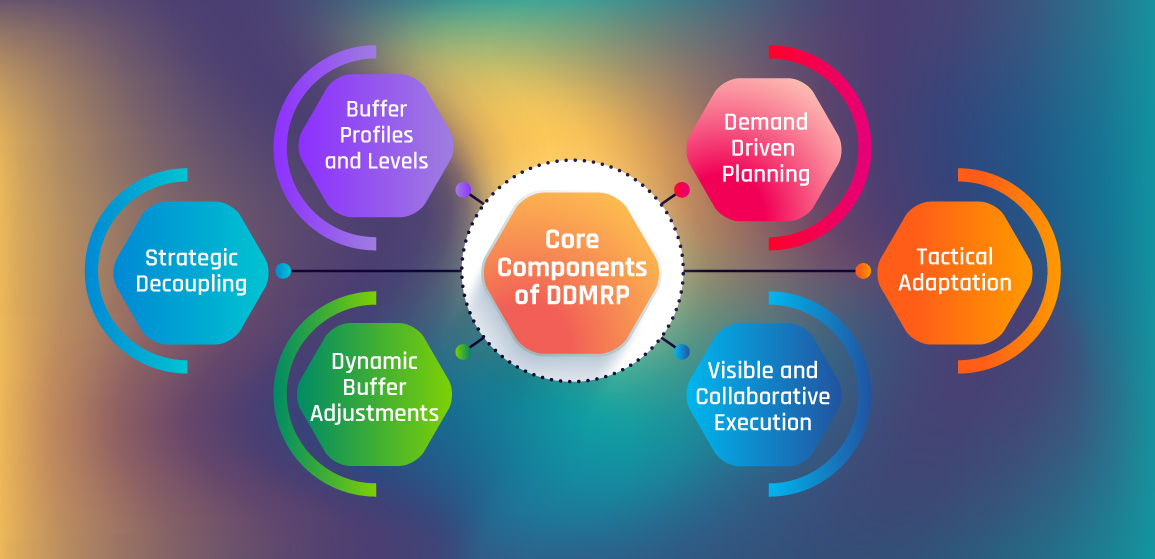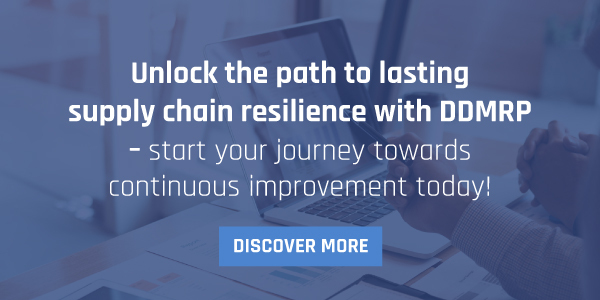
Best Practices for Using DDMRP to Enhance Cross-Functional Team Collaboration
September 20, 2024
Leveraging DDMRP to Build a More Agile and Customer-Centric Supply Chain
October 14, 2024Supply chain management has evolved significantly over the years, but the methods of replenishment have not always kept pace with the complexities of modern demand. Many businesses still rely on traditional replenishment methods, which focus on forecasts that may not align with real-time demand. These conventional strategies often result in excessive inventory, long lead times, and suboptimal customer service levels. However, a new methodology—Demand Driven Material Requirements Planning (DDMRP)—has emerged, offering businesses a more responsive, efficient way to manage replenishment. This blog will compare traditional replenishment methods with DDMRP’s demand-driven approach, highlighting how DDMRP’s dynamic response to real-time demand signals enables faster, more accurate replenishment. Additionally, it will discuss how businesses can leverage this agility to outperform competitors by reducing lead times, improving customer satisfaction, and eliminating excess inventory.
Introduction to Traditional Replenishment Methods
Replenishment, the process of restocking inventory to meet customer demand, is a critical aspect of supply chain management. Traditionally, replenishment methods have relied heavily on forecasts and historical data. These approaches, while effective in relatively stable markets, struggle to keep up with the unpredictable fluctuations of modern consumer demand.

Common Challenges in Conventional Replenishment Strategies
One of the most significant limitations of traditional replenishment is its dependency on forecasts. Forecasting demand is inherently uncertain and often leads to two major problems: overstocking and stockouts. Overstocking ties up capital in excess inventory, which may become obsolete or spoil, particularly in industries like food and fashion. On the other hand, stock outs cause lost sales, disappointed customers, and damage to a brand’s reputation.
Moreover, traditional methods often feature long lead times due to the static nature of replenishment decisions. Lead times are further exacerbated by the batch-oriented approach of many systems, where orders are placed based on pre-set intervals, regardless of the actual demand. This rigidity limits a company’s ability to respond swiftly to changes in demand, leading to inefficient use of resources and an inability to capitalise on market opportunities.
What is DDMRP? An Overview
Demand Driven Material Requirements Planning (DDMRP) represents a fundamental shift in how companies approach replenishment. DDMRP is an innovative methodology that builds on the principles of traditional MRP but incorporates real-time demand signals and buffer management to improve supply chain responsiveness.
Developed in 2011 by Carol Ptak and Chad Smith, DDMRP is rooted in the Demand Driven Adaptive Enterprise (DDAE) model. It aims to transform supply chains from being forecast-driven and reactive to demand-driven and proactive.
Core Components of DDMRP:
- Strategic Decoupling: The foundation of DDMRP begins with identifying strategic decoupling points, which act as buffers within the supply chain to minimise demand signal distortion and ensure supply continuity. These points are strategically chosen because they directly influence customer lead times and inventory investments. The decision to place decoupling points is crucial, and DDMRP employs six key criteria to determine the optimal locations within a given supply chain environment.
- Buffer Profiles and Levels: To maintain decoupling effectively, buffer sizes must be appropriately configured. In DDMRP, each decoupled item is assigned to a specific buffer profile. These profiles consist of settings applied to groups of items that share similar attributes, such as lead times, product hierarchy, and sensitivity to demand or supply variability. By utilising buffer profiles, organisations can efficiently manage large numbers of decoupled items across the supply chain.
- Dynamic Buffer Adjustments: DDMRP allows buffer levels at decoupling points to adapt over time based on changes in factors like demand rates, lead times, or significant upcoming events, such as promotions or seasonal shifts. DDMRP-compliant systems automate many of these adjustments, enabling supply chains to remain agile in response to real-time conditions.
- Demand Driven Planning: This component of DDMRP focuses on generating supply orders using specific rules, known as the net flow equation. These rules are applied to the DDMRP model to generate order recommendations, typically once a day, for all buffered positions. Demand generated from higher levels cascades to lower levels in the supply chain in a process called decoupled explosion, ensuring alignment between supply and actual demand.
- Visible and Collaborative Execution: In DDMRP, planning and execution are distinctly separate phases. Once an order recommendation is approved and converted into a scheduled receipt, execution begins. DDMRP execution manages these open orders through two alert types—Buffer Status Alerts and Synchronisation Alerts—which signal any potential disruptions that could affect customer commitments or the integrity of buffers. These alerts enable proactive management and maintain smooth flow throughout the supply chain.
- Tactical Adaptation: The final component of DDMRP involves adapting the model to changing circumstances. This adjustment process, known as Demand Driven Sales and Operations Planning (DDS&OP), ensures the DDMRP model remains aligned with both past performance and future expectations. DDS&OP replaces traditional Master Production Schedules (MPS) and introduces a more dynamic approach to planning, ensuring that the system remains responsive to evolving demand and supply conditions.

Comparing Traditional Replenishment with DDMRP
The transition from traditional replenishment methods to DDMRP represents a paradigm shift. The most significant difference lies in the static nature of traditional systems versus the dynamic, real-time responsiveness of DDMRP.
Traditional Replenishment: A Static Approach
Traditional methods are heavily reliant on forecasts, which are created using historical data, seasonal trends, and market projections. While this can work in stable environments, it struggles to keep up with unpredictable demand shifts. Stockouts, excess inventory, and long lead times are common challenges because the system is not responsive to actual demand changes. Lead times are often fixed, and replenishment cycles are based on predefined intervals, making it difficult to adapt to short-term fluctuations.
DDMRP: A Dynamic, Real-Time Solution
DDMRP, on the other hand, is built to be agile. By decoupling inventory at strategic points and using demand-driven buffers, DDMRP can adjust to real-time demand signals. Rather than relying on forecasted demand, DDMRP continuously updates replenishment needs based on what is actually being consumed. This flexibility allows businesses to respond faster to changes in demand and market conditions, reducing the risk of excess inventory or shortages.
Additionally, DDMRP’s ability to dynamically adjust buffer levels based on demand variability, lead times, and other external factors ensures that companies maintain optimal stock levels without overstocking or running out of critical items.
The Competitive Edge of Faster, More Accurate Replenishment
Companies that can replenish inventory faster and more accurately are better positioned to meet customer expectations and capitalise on market opportunities. DDMRP’s ability to react swiftly to real-time demand signals gives businesses a significant advantage over competitors using traditional replenishment methods.
Reduced Lead Times
Traditional replenishment methods often result in longer lead times due to the reliance on forecast-driven orders and predefined intervals. In contrast, DDMRP’s decoupling points and real-time adjustments reduce the need for long lead times. By strategically placing inventory buffers and responding to actual demand signals, companies can significantly shorten their replenishment cycles.
This reduction in lead times allows businesses to operate with greater agility, quickly responding to customer orders, market shifts, or production disruptions. Companies that can deliver products faster gain a competitive advantage by increasing customer satisfaction and reducing lost sales due to stockouts.
Improved Forecast Accuracy
Although DDMRP does not eliminate the need for forecasts, it reduces their importance by shifting the focus to actual consumption data. By reacting to real-time demand, companies no longer have to depend on long-range forecasts, which are often inaccurate. The dynamic nature of DDMRP ensures that inventory levels are adjusted based on what is actually happening in the supply chain, not what was predicted months ago.
This increased accuracy translates to better decision-making, reduced costs, and a more efficient supply chain overall.
Eliminating Excess Inventory: A Key Benefit of DDMRP
One of the biggest challenges companies face in traditional replenishment systems is the risk of carrying excess inventory. To avoid stockouts, businesses often overstock, leading to increased carrying costs, potential obsolescence, and wasted resources. DDMRP addresses this issue head-on by using demand-driven buffers to optimise inventory levels.
How DDMRP Reduces Overstock
Unlike traditional methods that rely on safety stock calculations, DDMRP’s buffer zones dynamically adjust to changes in demand. The green zone represents the ideal Net Flow level, while the yellow and red zones signal caution and the need for replenishment. These zones are continuously updated based on actual consumption and demand variability, ensuring that inventory is always optimised.
This approach eliminates the need for large safety stocks, which are often a buffer against forecast errors in traditional systems. By replenishing inventory only when it’s consumed, companies avoid the costs and risks associated with excess inventory.

Balancing Inventory with Demand
DDMRP’s focus on aligning inventory with real-time demand ensures that stock levels are always in sync with consumption patterns. This balance not only reduces the risk of overstock but also minimises stock outs, improving overall supply chain efficiency.
Companies can therefore operate with leaner inventories, freeing up working capital for other investments while still ensuring they can meet customer demand.
Enhancing Customer Satisfaction with DDMRP
Meeting customer expectations is critical to staying competitive. Traditional replenishment methods often struggle to keep pace with fluctuating demand, resulting in stockouts, backorders, and delayed shipments. This can lead to frustrated customers and lost sales.
DDMRP’s ability to respond quickly to real-time demand signals ensures that companies can meet customer expectations with greater accuracy and reliability.

Meeting Customer Expectations with Timely Replenishment
Because DDMRP focuses on actual demand rather than forecasted demand, companies can replenish stock more efficiently and in real-time. This ensures that products are available when customers need them, reducing the likelihood of stockouts or delays.
For businesses operating in industries with high demand variability or short product life cycles, this ability to respond quickly to changing market conditions is a game-changer. Customers receive their products on time, and companies can build stronger relationships with their clientele.
Higher Service Levels Through Real-Time Responsiveness
In traditional systems, long lead times and static replenishment cycles can negatively impact service levels. DDMRP’s demand-driven approach allows companies to react to shifts in demand and ensure they are always meeting customer needs. This leads to higher service levels, fewer backorders, and a more efficient supply chain.
As customer satisfaction improves, so does brand loyalty. Businesses using DDMRP can set themselves apart from competitors by consistently delivering on their promises, creating a competitive advantage in the marketplace.
Implementing DDMRP: Steps to Transition from Traditional Replenishment
Transitioning from traditional replenishment methods to DDMRP requires careful planning and execution. Here are the key steps companies should take to successfully implement DDMRP:
- Assess the Current Supply Chain: Evaluate your current replenishment processes, lead times, and inventory levels to identify areas where DDMRP can provide the most value.
- Identify Strategic Decoupling Points: Determine the key points in your supply chain where inventory buffers should be placed to decouple demand and supply variability.
- Set Up Buffer Profiles and Zones: Establish buffer profiles for each decoupling point based on demand variability, lead times, and replenishment frequency.
- Implement Demand-Driven Planning Tools: Use software tools designed for DDMRP to help manage buffers, track real-time demand signals, and adjust replenishment levels dynamically.
- Train Supply Chain Teams: Ensure that all relevant stakeholders, including supply chain planners, procurement teams, and production managers, are trained on the principles and processes of DDMRP.
- Monitor and Adjust: Use the Demand Driven S&OP process to continuously monitor the performance of the DDMRP system and make adjustments as needed to ensure optimal inventory levels and responsiveness.

Why DDMRP is the Future of Supply Chain Management
As businesses continue to face increasing uncertainty and complexity in their supply chains, the need for more agile and responsive replenishment methods is becoming more critical. DDMRP offers a forward-thinking solution that addresses many of the shortcomings of traditional systems.
Long-Term Advantages of DDMRP
DDMRP’s ability to reduce lead times, improve inventory management, and enhance customer satisfaction makes it a valuable tool for companies looking to stay competitive. As global supply chains become more interconnected and demand patterns more unpredictable, businesses that can respond quickly and accurately will be the ones that thrive.
Additionally, DDMRP’s focus on real-time data and dynamic adjustments positions it as a future-proof solution for supply chain management. Companies that adopt DDMRP today will be better equipped to handle the challenges of tomorrow’s supply chains.
Conclusion: Turning Replenishment into a Competitive Advantage with DDMRP
In conclusion, Demand Driven Material Requirements Planning (DDMRP) offers a powerful alternative to traditional replenishment methods. By leveraging real-time demand signals, dynamic buffer management, and strategic decoupling points, businesses can gain a significant competitive advantage.
DDMRP allows companies to reduce lead times, optimise inventory levels, and improve customer satisfaction, all while lowering costs and minimising risk. As businesses continue to face increasing competition and market volatility, adopting DDMRP can provide the agility and responsiveness needed to stay ahead of the curve.
Ultimately, DDMRP transforms replenishment from a reactive, forecast-driven process into a proactive, demand driven strategy. Companies that embrace this approach will be well-positioned to outperform their competitors and succeed in today’s dynamic business environment.
Explore how DDMRP can transform your traditional replenishment process into a competitive advantage.





